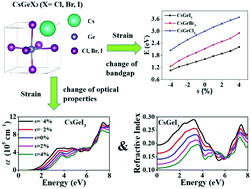Strain-induced bandgap engineering in CsGeX3 (X = I, Br or Cl) perovskites: insights from first-principles calculations†
Abstract
Based on density functional theory and following first-principles methods, this paper investigated the electronic structures, densities of states, effective masses of electrons and holes, and optical properties of CsGeX3 (X = I, Br or Cl) perovskites under triaxial strains of −4% to 4%. The calculated results show that the tuning range of the bandgaps of the CsGeI3, CsGeBr3, and CsGeCl3 perovskites are 1.16 eV, 1.64 eV, and 1.63 eV, respectively. This result shows that the bandgap of the CsGeX3 perovskite is tuned over the entire visible spectrum by applying strain. Also, it is found that the change of the bandgap is caused by the change of the Ge–X long bond. Besides, the optimal bandgaps of CsGeI3 and CsGeBr3 can be achieved by applying compressive strains, providing theoretical support for adjusting the bandgaps of CsGeX3 perovskites. The effective masses of electrons and holes of CsGeX3 perovskites decrease gradually with the strains changing from 4% to −4%, which is conducive to the transmission of electrons and holes. In addition, the optical properties of CsGeX3 perovskites change from redshifted to blueshifted under different strains.



 Please wait while we load your content...
Please wait while we load your content...